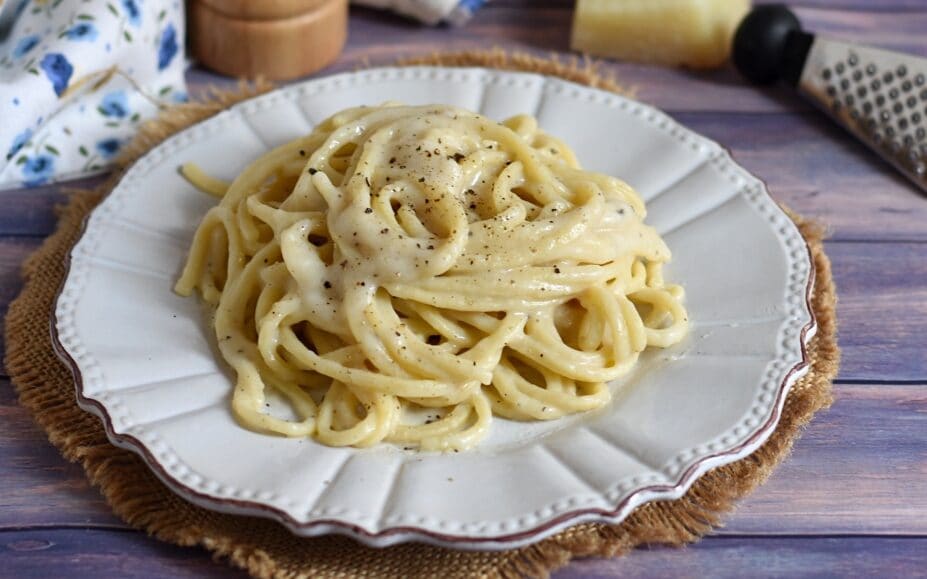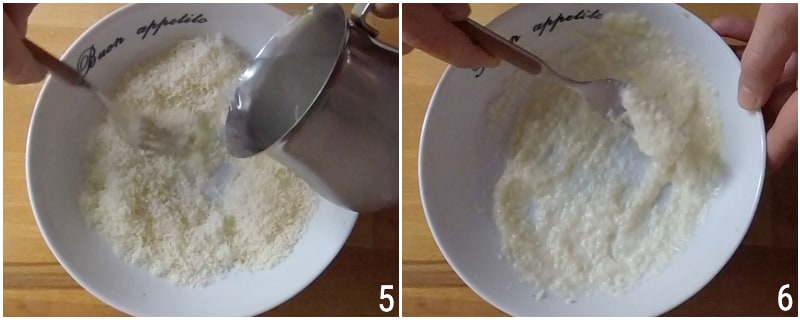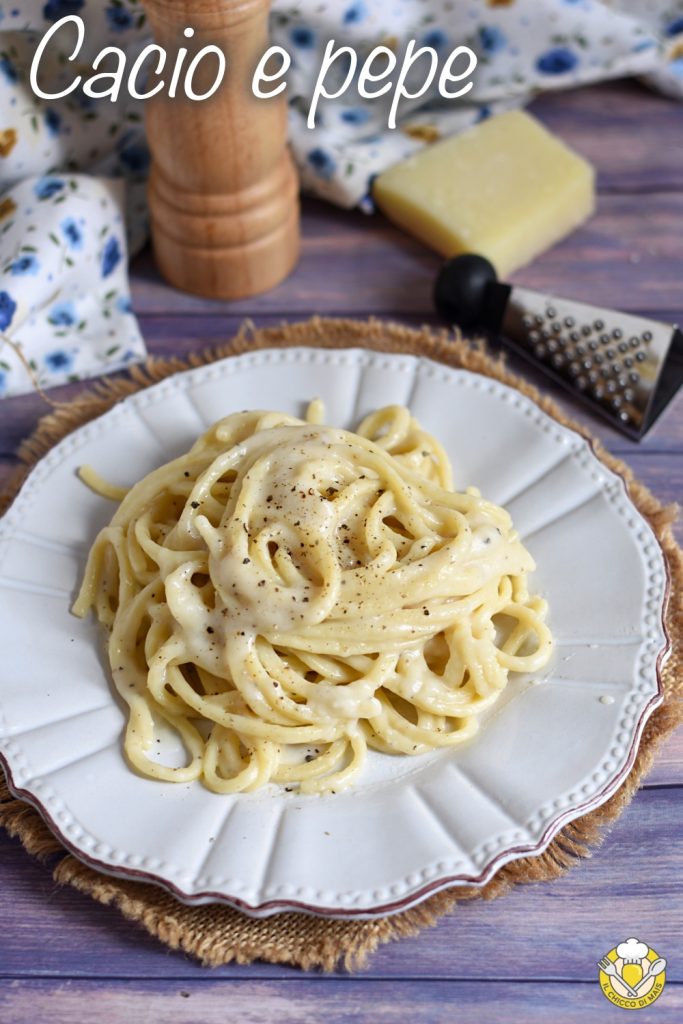The cacio e pepe, together with the carbonara and the gricia, is one of the most famous and appreciated dishes of Roman cuisine. Despite the apparent simplicity – only 3 ingredients: pasta, Pecorino Romano, and black pepper – achieving a creamy and lump-free cacio e pepe is not so easy: there are many variables at play and tips to prevent the cheese from clumping, that even the most experienced cook may occasionally get it wrong.
If you want to try making the traditional cacio e pepe, arm yourself with a bit of patience and do not be discouraged on your first attempt: experience plays a crucial role here, and with some tries, you will be able to correct the errors over time. I hope to help you by giving you my creamy cacio e pepe recipe and, below, a series of tricks and tips to prepare this delicious dish perfectly!
If you love tonnarelli cacio e pepe you should also try:

- Difficulty: Medium
- Cost: Very cheap
- Preparation time: 2 Minutes
- Portions: 4 servings
- Cooking methods: Stove
- Cuisine: Regional Italian
- Seasonality: All seasons
Traditional Cacio e Pepe Ingredients
If you are celiac choose a starch-rich pasta, preferably fresh: for example tonnarelli or pici.
- 13 oz egg spaghetti alla chitarra (tonnarelli)
- 8.5 oz Pecorino Romano (DOP, freshly grated)
- 2.5 tsp black pepper (freshly ground + to taste for garnish)
Tools
- 1 Pot
- 1 Pan non-stick
- 1 Bowl
- 1 Small pot
- 1 Tongs for spaghetti
How to Prepare Creamy Cacio e Pepe Pasta
 For the English version of this recipe click here!
For the English version of this recipe click here!
The cacio e pepe sauce must be prepared in the time it takes for the pasta to cook, as you will need its cooking water. Bring plenty of water to a boil and salt it with about half of the coarse salt you would normally use, to avoid a too salty dish. Then plunge the pasta (1) and cook it for a couple of minutes less than the cooking time indicated on the package.
While the pasta is cooking, prepare the sauce: grind the pepper with a pestle or grinder and put it in a non-stick pan. Turn the heat to medium and let the pepper toast for about a minute, so it releases all its aroma (2).

With a small pot, take some pasta cooking water and pour it into the pan with the pepper (3). You will see it bubble right away (4). Let it cook for another ten seconds, then turn off the heat.

It’s time to prepare the Pecorino cream: put the grated Pecorino in a bowl; take another small pot of pasta cooking water – which will now be rich in starch – and let it cool for about 20 seconds, then pour it little by little into the bowl with the Pecorino, stirring immediately with a fork with quick motions, as if you were beating eggs (5).
As you blend the Pecorino cream, add more water little by little, until you form a dense and pasty mixture (6). It’s not easy to indicate the precise amount of water to use, it will be about a glass, but keep in mind that you can adjust the sauce’s density later if needed.

When you’re about to drain the pasta, turn the heat back on under the pan with the pepper. Drain the tonnarelli with a spaghetti tongs, so you don’t discard their cooking water, and transfer them immediately into the pan.
Risotto the pasta for a minute or two, until it’s cooked, adding a little more cooking water. You will see that the starch will have already formed a kind of cream along with the pepper (7).
Remove the pan from the heat and let the pasta rest for about twenty seconds, so it’s not scorching hot, then transfer it along with its cooking liquid into the bowl with the Pecorino cream. Stir immediately with the spaghetti tongs (8) or with two forks, adding a little more cooking water if the cream seems too dry or more Pecorino if it’s too liquid.

Garnish the tonnarelli cacio e pepe with more freshly ground black pepper and serve immediately.
To achieve a perfect cacio e pepe, with a dense and velvety cream without lumps, you must start with the choice of ingredients which are just three… plus a fourth secret ingredient!
The pasta: here in Rome, the most common pasta shape for cacio e pepe is not spaghetti but tonnarelli or spaghetti alla chitarra, fresh egg pasta originally from Abruzzo but widespread throughout central Italy. The reason is simple: fresh pasta releases much more starch when cooked, which helps to make the Pecorino sauce creamier. Also, the rough surface of this pasta holds the sauce better. In the absence of tonnarelli, you can opt for fresh pici, or high-quality dry spaghetti, quite rough and not too thin.
The cheese: the “cacio” in cacio e pepe is Pecorino Romano DOP which for a perfect result must be slightly aged. The more aged the cheese, the less water it contains and the more it will tend to melt and form lumps when it comes into contact with heat. For the same reason, it is better to avoid pre-grated Pecorino – which dries out over time – and grate it just before preparing the pasta.
The pepper: use freshly ground black pepper – or crushed with a pestle – and not too finely. If you toast it in the pan as indicated in the recipe, it will release all its aroma, which goes beyond the spicy note. The quantity can vary based on taste: with 2 grams per person, in my opinion, you get a tasty but balanced dish that is not too aggressive.
The cooking water: here’s the secret ingredient of cacio e pepe! Nice discovery, you might say, it’s the secret ingredient of all white pasta recipes tossed or risottoed, for example, spaghetti alle vongole. However, in cacio e pepe the cooking water should not be added randomly but well measured – they say it should be equal in weight to the Pecorino, but I tend to put less at first and adjust it during tossing if necessary – and it should not be freshly taken from the pot. Just letting it cool for 20-30 seconds is enough to prevent or at least limit the dreaded lumps.

Why does the cacio e pepe cream “clump” or “lump”?
This is the most common mistake in making cacio e pepe that I think everyone – from the most skilled chefs to Roman housewives of 7 generations – has encountered at least once in their life. So if it happened to you, don’t be discouraged, you’re in good company! Joking aside, this inconvenience can be due to two reasons (one, the other, and sometimes both simultaneously):
1. You added the cooking water to the Pecorino without stirring immediately or without letting it cool slightly: the excessive heat melted the cheese and created the infamous lumps. Let the cooking water rest for 20-30 seconds after taking it from the pot and add it little by little while rapidly stirring the Pecorino with the other hand.
2. You used overly aged Pecorino: the more a cheese is aged, the drier it is and thus it will tend to “clump” when in contact with heat that coagulates the proteins inside. Even with aged Pecorino, it’s possible to make a creamy cacio e pepe, but it’s certainly more difficult. Why make life harder for yourself?
Unfortunately, once the cacio e pepe sauce has formed lumps it is impossible to recover it and it must be remade from scratch. The difficulty of this recipe lies precisely in the particular chemical balance of its components. If you want to practice making Pecorino cream with a similar but slightly simpler recipe, I recommend the pasta alla gricia: same ingredients but with the addition of guanciale. The fat it contains slows down the coagulation of proteins making your task easier!

